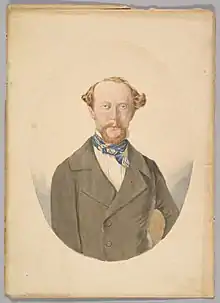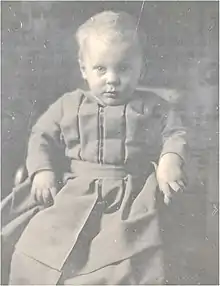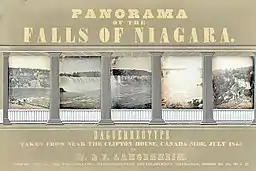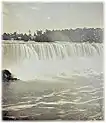Frederick Langenheim
Frederick Langenheim (May 5, 1809 – July 16, 1879) was a German-American photographer and pioneer of stereoscopic photography. With his brother, he made the first set of panoramic pictures of Niagara Falls and a sequential set of pictures of the first American total solar eclipse ever photographed.
Frederick Langenheim | |
|---|---|
 circa 1850 | |
| Born | May 5, 1809 |
| Died | January 10, 1879 (aged 69) Philadelphia, United States |
| Nationality | American |
| Occupation | Photographer |
| Known for | Niagara Falls panoramic pictures |
Notable work | American solar eclipse pictures |
Early life
Langenheim was born with given names Frederick David in Brunswick, Germany, on May 5, 1809.[1] He emigrated to America in 1840 to Philadelphia where his older brother William was already living.[2] William had immigrated to America in 1834 and lived in Texas for a while before moving to Florida and eventually to Philadelphia in 1839.[3] Their father Friedrich Wilhelm was mayor of Schoningen, Germany, from 1808 to 1813.[4]
Mid life and career
In 1840, Langenheim and his brother William began working for a German language newspaper edited by George Francis Schreiber in Philadelphia. Langenheim acquired a daguerreotype camera from Von Voigtlander and formed a partnership with Schreiber in a photographic studio business for a couple of years in 1841.[2] In 1843 Langenheim went into the photography studio business with his brother at 26–27 Exchange Street in Philadelphia. It was the W. & F. Langenheim firm and known as the Philadelphia daguerrotype establishment.[3] They made in 1842 the first advertising picture in history.[7] It was of patrons eating and drinking in the restaurant in the Philadelphia Exchange Building. The picture of people dining was hung in the hall of the building to attract potential customers for the dining room.[8][9][10]
In 1845, Langenheim took the first set of panoramic pictures of Niagara Falls ever photographed.[11][12][2] The panoramic set of five adjacent scenes were placed in panels in a display frame.[13][14] The daguerreotype pictures were the first of Niagara Falls according to photo historian Robert Taft (1894-1955).[13][15] They were the first such pictures to gain world fame.[16][17] There were eight sets of copies made. A set was sent to the photographer Louis Jacques Mandé Daguerre and five crowned heads of Europe, Queen Victoria, and one each to the reigning rulers of Brunswick, Prussia, Saxony, and Wurttemberg.[16] The seventh set was given to United States president James Knox Polk and the eighth set was retained by the Langenheim brothers.[11]
_palms%252C_Florida%252C_by_American_Stereoscopic_Company.jpg.webp)
Langenheim invented a technique in 1846 for coloring daguerreotype plates and was issued a patent for it.[18][19] With his brother in 1849 Langenheim used a photography technique invented by Abel Niépce de Saint-Victor which produced negative lantern glass slides.[20][14] They renamed it "hyalotype" photography and patented it in 1850.[21] The hyalotype glass slides were produced by an albumen process and were used for views of historic buildings in New York City, Philadelphia, and Washington, D.C.[14] These slides were also used in portraits of famous Americans.[22] In 1850, Langenheim with his brother introduced stereoscopy and were the first Americans to sell stereocards to the public.[23] Langenheim and his brother were the first to produce stereographs commercially in America. They operated the American Stereoscopic Company from about 1850 to 1860 in Philadelphia.[24][25]



On May 26, 1854, Langenheim and his brother took interval timed pictures of the first American total solar eclipse ever photographed.[26][27] There were eight phases taken of different time sequences and are the earliest known eclipse pictures taken in the United States.[28][29] The seven surviving pictures are owned by the Metropolitan Museum of Art.[26] The pictures range in size from 1.25 inches (3.2 cm) high by 1 inch (2.5 cm) wide to 2.8125 inches (7.144 cm) high by 2.3125 inches (5.874 cm) wide.[26] Six daguerreotypists and another photographer took images of the event, but only the Langenheim ones survive.[26]
Later life and death
Langenheim and his brother William were active in selling photographs until William died in 1874; at that point, Langenheim retired. He died in Philadelphia on January 10, 1879.[31]
References
- Newhall 1976, p. 148.
- Robinson 2001, p. 158.
- Brey 1992, p. 99.
- "The 1st photographs of s total solar eclipse". The History Blog. 2017. Retrieved August 23, 2020.
- The Pennsylvania Magazine of History and Biography, 4, Publication Fund of the Historical Society of Pennsylvania, 1940, p. 298
- "Society News". The Pennsylvania Magazine of History and Biography. Publication Fund of the Historical Society of Pennsylvania. 1940. p. 298.
- LCP 1981, p. 266.
- Craig 1994, p. 338.
- Pennsylvania Arts and Science, 4, Pennsylvania Arts and Science Society, 1940, p. 20,
In 1845 Frederick journeyed to Niagara Falls and made a series of daguerreotypes of this American scenic wonder, the first ever taken of the Falls.
- "Panorame of Niagara Falls". The MET. Metropolitan Museum of Art. 2017. Retrieved August 25, 2017.
- Witkin 1979, p. 179.
- Naef 2004, p. 52.
- "Missouri Historical Society". Quarterly Journal of the Missouri Historical Society. 6: 30. 1985. Retrieved September 20, 2017.
In 1845, they successfully produced several multi-plate views of Niagara Falls, which photo historian Robert Taft designates as the first camera-made pictures of the scenic wonder.
- Kane 1997, p. 414.
- Daguerreian Society 1993, p. 19.
- Hambourg 1993, p. 310.
- Ostroff 1987, p. 189.
- Gernsheim 1986, p. 16.
- Taylor 2013, p. 179.
- Rossell 1998, p. 24.
- Frederick Langenheim bio
- Darrah 1977, p. 26.
- Simons 1857, p. 50.
- "Eclipse of the Sun". All Collection Records. Metropolitan Museum of Art. 2017. Retrieved August 25, 2017.
- Miller 2016, p. 3.
- Marien 2006, p. 35.
- Daguerreian Society 1993, p. 71.
- Wilson 1880, p. 20.
Sources
- Brey, William & Marie (1 January 1992). Philadelphia Photographers, 1840–1900. Willowdale Press. ISBN 978-0-9613955-1-3.
- Craig, John S. (1994). Craig's Daguerreian Registry. John S. Craig. ISBN 0964380811.
- Daguerreian Society (1993). The Daguerreian Annual. The Society.
On view were a most remarkable series of daguerreotypes of an eclipse of the sun on May 26, 1854, by Frederick Langenheim, the oldest known eclipse photos taken in the United States. The museum also displayed the first photographic pictures ever made of Niagara Falls. Eight sets of five daguerreotypes were made by the Langenheims in 1845.
- Darrah, William Culp (June 1977). The world of stereographs. Darrah.
- Gernsheim, Helmut (1986). A Concise History of Photography. Courier Corporation. ISBN 978-0-486-25128-8.
- Hambourg, Maria Morris (1993). Photography's First Century. Metropolitan Museum of Art. ISBN 978-0-87099-662-7.
- Hannavy, John (2008). Encyclopedia of nineteenth-century photography. Taylor & Francis. ISBN 978-0-415-97235-2.
- Kane, Joseph Nathan (1997). Famous first facts. H.W. Wilson. ISBN 978-0-8242-0930-8.
The first photographs to gain world fame was a daguerreotype panorama of Niagara Falls, NY, taken in July 1845 by William and Frederick Langenheim of the Philadelphia Daguerrotype Establishment, Philadelphia, PA, from a site near the Clifton House on the Canadian side of the falls.
- LCP (1981). Quarter of a Millennium:. Library Company of Philadelphia. ISBN 978-0-914076-81-0.
Their international reputation came as a result of their work at Niagara Falls in 1845. Sets of Niagara Falls plates, the first taken of what became the most photographed scene in America, were sent to six crowned heads of Europe.
- Marien, Mary Warner (2006). Photography Cultural History. Laurence King Publishing. ISBN 978-1-85669-493-3.
- Miller, Roland (1 March 2016). Preserving America’s Space History. UNM Press. ISBN 978-0-8263-5626-0.
- Naef, Weston J. (2004). Photographers of Genius. Getty Publications. ISBN 978-0-89236-749-8.
- Newhall, Beaumont (1976). Daguerreotype in America. Courier Corporation. ISBN 978-0-486-23322-2.
- Ostroff, Eugene (1987). Pioneers of photography. SPSE. ISBN 978-0-89208-131-8.
- Robinson, David (2001). Encyclopaedia of the Magic Lantern. Magic Lantern Society. ISBN 978-0-9510441-5-5.
- Rossell, Deac (1998). Living Pictures... SUNY Press. ISBN 978-0-7914-3767-4.
- Simons, S. P. (1857). Plain instructions for coloring photographs. Collins.
- Taylor, Maureen (15 February 2013). Preserving Your Family Photographs. BookBaby. ISBN 978-0-9848450-5-7.
- Wilson, E. L. (1880). Photographic Mosaics. E.L. Wilson.
- Witkin, Lee D. (1979). The photograph collector's guide. New York Graphic Society. OCLC 470223777.
External links
| Wikimedia Commons has media related to Frederick Langenheim. |

